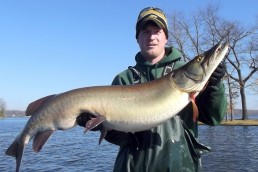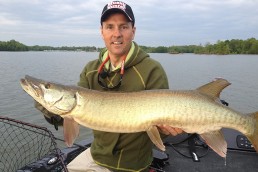Muskies on the Flambeau Chain
SHARE THIS POST
The Flambeau Chain of Lakes is a 10-lake chain that offers some of the best fall muskie fishing in the state of Wisconsin. The lakes are scattered around Highway 47, just north and west of Woodruff. Most of the lakes lie in the Lac du Flambeau Reservation, which is part of the Ceded Territory, where special bag and length limits may apply.
The DNR had not stocked these lakes since 1974; fish populations have been self-sustaining, with good numbers, plus some big fish. The new DNR and Lac du Flambeau tribal fisheries are now supplying fish to the Chain to supplement the natural reproduction.
The late Tommy “Tadpole” Zinda, who guided anglers for decades on the chain, told me that Flambeau Lake was one of his favorites. While Flambeau Lake is only 1,176 acres and one of the chain’s smallest waters, that doesn’t mean the fishery is sub-par. The lake contains a good muskie population, with high numbers and big fish. Zinda told me some years back that Flambeau Lake has “trophy northern pike and some huge muskies,” including a 51-pound fish caught in the 1970s.
Some of the Flambeau Chain’s other lakes are clear, deep and full of forage (smelt), making fishing difficult much of the year. The smelt go deep in the summertime, and the muskies, walleyes, and northerns all follow them to deeper water, where they’re harder to catch.
Zinda, however, always said that Flambeau Lake is an easy lake to fish for muskies. As the season progresses, the lake develops one of the finest weed edges in the area, with good weeds along the southern, western and northwestern shorelines. Don’t be afraid to fish the weeds as long as they still are green and lush. The top spots for fall fishing include Medicine Rock Point near the sandbar, the deep break off the southwest shore, and the waters around Strawberry Island. The maximum depth of Flambeau Lake is 78 feet, with a mean depth of 28 feet. The bottom is made up of mostly sand, gravel, rock, and muck. The lake’s waters are clear with good visibility most of the year.
Are you enjoying this post?
You can be among the first to get the latest info on where to go, what to use and how to use it!
Fall is the time of the year when big muskies bulk up for the winter, and by the time you read this, the muskies should be going into their fall patterns, which may include suspending over deep water while chasing the smelt. Row-trolling big crankbaits is a good technique that works well on this lake, and on most of the others in the chain. Suckers on Quick-Set rigs should always be at boatside this time of the year. Don’t be afraid to cast crankbaits, jerkbaits and bucktails as well. The best colors seem to be black, white, orange and perch.
After talking to another Hall of Fame muskie guide Russ Smith, I found that the water is still around 60 degrees, and some weeds are just starting to die off. Turnover will be happening soon, when the water cools to 50 to 55 degrees. This signals to the fish that winter is coming and it’s time to feed. The best muskie fishing of the year is just around the corner and by the time you read this, the fishing should be hot!
The muskie fishing season is open til the end of November. Most years, the fishing is done by the second or third week of November, but you never know. Many big fish are caught when there is snow on the ground, just before the lakes freeze solid.
Public access is available from the waters of the rest of the chain, or you can launch at a fee landing at the campground and marina off Highway 47, in the town of Lac du Flambeau.
MWO
SHARE THIS POST
You may also like...
Did you enjoy this post?
You can be among the first to get the latest info on where to go, what to use and how to use it!
Gary Engberg
If you have any questions or comments you may reach Gary Engberg at 608-795-4208 or garyengbergoutdoors.com.



